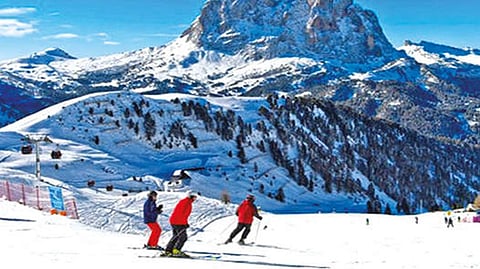

CHENNAI: If you want to see firsthand the impact of climate change, take a trip to Es Trenc, one of Mallorca’s finest beaches. Here, massive concrete bunkers — built in the mid-20th century by the Spanish dictator Francisco Franco — were originally hidden amid the sand dunes. Today, these structures stand out like sore thumbs: Rising sea levels have swallowed up parts of the beach and radically altered this coastal landscape. In total, scientists have found that Es Trenc beach is now 40 meters (130 feet) shorter than it once was. Should global warming continue as projected, many more Mallorca beaches will disappear into the sea.
“We are seeing large-scale land loss in the Mediterranean region,” said Thomas Dworak, who coordinated a study by Germany’s federal environment agency on the effects of global warming on tourism that was published in 2021. This is a very concerning prospect for islands such as Mallorca, which are popular with holidaymakers precisely because of their expansive beaches. For now, though, none of this is reflected in visitor numbers. On the contrary: Mallorca is seeing a record number of guests this summer.
“There is little evidence to suggest that people are changing their travel behavior because of climate change,” Dworak said. Though warnings about the consequences for the tourism industry have been mounting for many years, he said there had only been a few studies that demonstrate the potential for concrete effects.
“Many Europeans are creatures of habit,” Dworak said. “Someone who spent the past 20 years going on holiday in Italy will keep doing just that.” Even such shocking natural disasters as the glacier collapse in Italy’s Dolomites in early July, which killed 11 people, do not seem to leave a lasting impression strong enough to change people’s minds.
“If the very same locations suffer repeated flooding, or glacier collapses, it will eventually impact tourism in that region,” said Dagmar Lund-Durlacher, a professor of sustainable tourism management at Modul University Vienna. But, so far, she said, such events have occurred sporadically in different areas. “People are aware of the danger,” she said, “but they don’t associate it with a specific region.” The Caribbean, she said, is an exception. In September 2019, tropical storm Dorian hit the Bahamas, causing massive destruction, which brought the tourist sector to its knees.
Ski resorts are in some of the regions hit hardest by global warming, as rising temperatures reduce the amount of snowfall. “This is where the connection between climate change and tourism is most apparent,” Dworak said. “If a ski resort received little or no snow for several consecutive years, winter sports enthusiasts will stay away.”
Alpine regions know this problem all too well, though many have resorted to snow cannons to make up for missing snowfall. Artificial snow production, South Tyrol Tourism Minister Arnold Schuler said, has served the region in northern Italy well. Tourists keep coming in the winter months to go skiing and snowboarding. So far, visitor numbers in winter and summer have remained stable. Still, Schuler said, artificial snow production only works at certain low temperatures. There are already areas in South Tyrol where skiing is no longer possible all year round because of shrinking glaciers and rising temperatures. Vanishing beaches, a higher frequency of storms and floods, and a lack of snowfall are only some consequences of global warming that are bound to have an impact on the tourist industry. Droughts and heat waves will also put tourists off visiting affected regions, as experts have warned for years.
This article was provided by Deutsche Welle
Visit news.dtnext.in to explore our interactive epaper!
Download the DT Next app for more exciting features!
Click here for iOS
Click here for Android